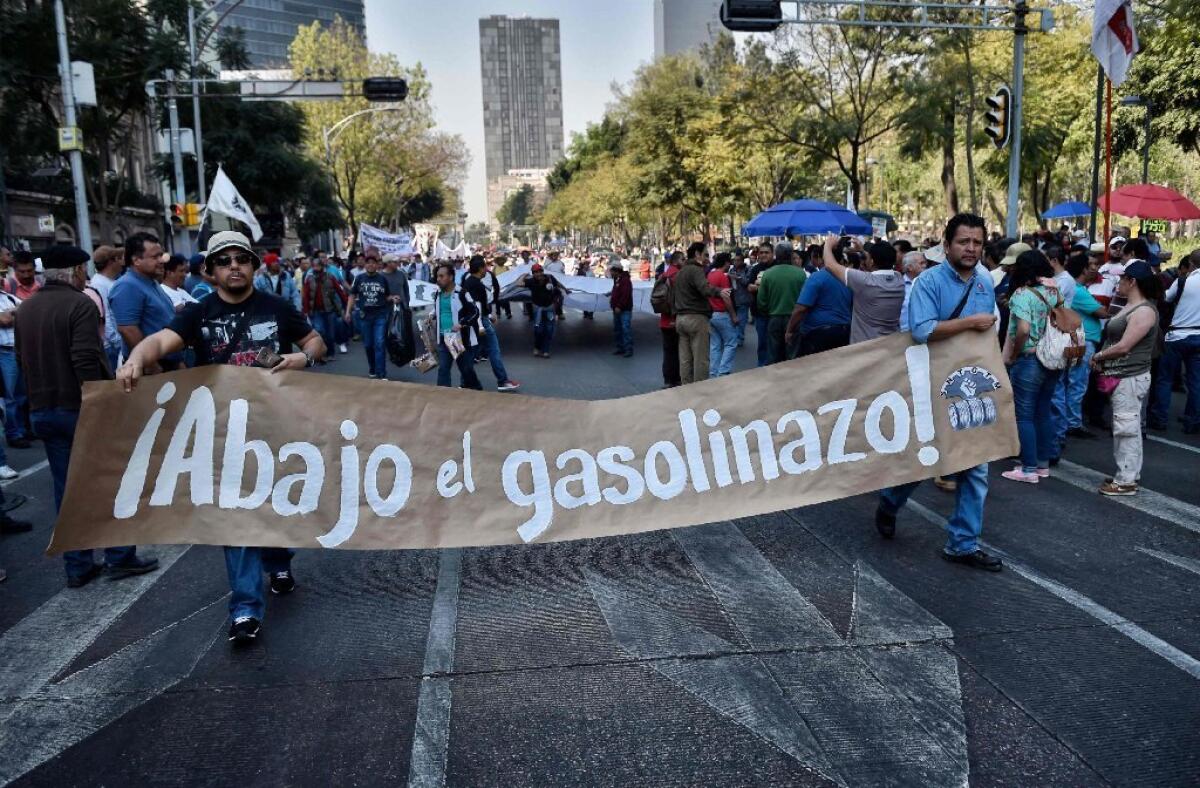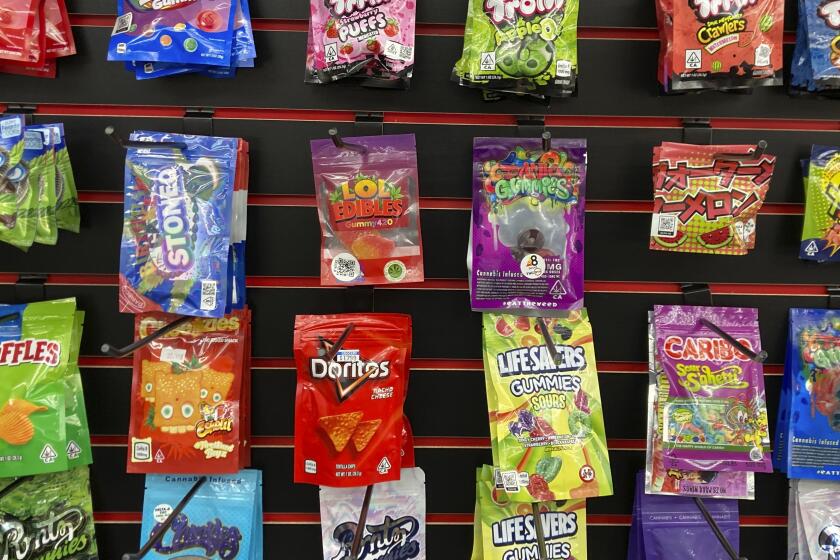Boiling over on the border: The reasons behind the gasoline protests in Mexico

At a gas station in Tijuana last week, cab driver MartĂn Canseco talked angrily about the dramatic surge in gasoline prices that has touched off sometimes deadly protests.
âI cannot feed my family; itâs too hard,â he said as the digits flew by on the pump filling up his van.
His remarks echo those of millions across Mexico, where the governmentâs decision to accelerate increases to gasoline prices is part of a larger, more ambitious effort to reform the entire countryâs inefficient and sclerotic state-run energy sector.
Most economists agree that a less regulated environment will better allocate resources and encourage much-needed investments.
The transformation was going to be difficult under ideal circumstances but conditions have quickly become more complicated in Mexico, where half the population lives in poverty and political leaders are churning through a new host of challenges, including one from the new U.S. president.
For many, the gas price increase was, in the words of a Mexican adage, the drop that made the glass spill over.
âPeople are already making miserable wages,â said Tijuana resident Israel Lopez, speaking in Spanish as he took a walk near the beach with his wife. âCan you imagine a guy making 600 pesos [$29] at a factory and he has kids and a family? What are they going to do?â
Each weekend since the price hikes were announced, thousands of angry residents have taken to the streets, prompting authorities to block freeway access into Mexico from San Ysidro.
In nearby Rosarito, a man intentionally drove his pickup into a group of federal officers. Across the country, at least four people have been killed and more than 1,500 arrested.
Mexicans call the price increase gasolinazo â literally, âgasoline blowâ â and it has become a flashpoint for anger over larger, long-simmering issues in Mexico that include chronic complaints about government patronage, favoritism and corruption.
Even those who favor reforming Mexicoâs energy system have blasted the way the government of President Enrique PeĂąa Nieto has handled the politics of the price increase.
âThey simply threw the baby into the water and said, âSink or swim,â â said Tony Payan, director of the Mexico Center at the Baker Institute for Public Policy at Rice University. âAnd of course, the baby is sinking.â
They simply threw the baby into the water and said, âSink or swim.â And of course, the baby is sinking.
— Tony Payan, director of the Mexico Center at the Baker Institute for Public Policy at Rice University
In 1938, Mexicoâs government nationalized the countryâs oil industry. The move pushed out foreign companies and created Pemex, the state petroleum company that became, for many, a source of national pride.
But for decades, the energy industry was poorly run and riven with corruption.
Oil refineries, for example, operate so unproductively that even though Mexico is one of the worldâs top producers of crude, one-third to one-half of the countryâs gasoline is imported from the United States.
In an increasingly globalized economy and international energy landscape, the Mexican government heeded the calls of most economists to break up its state-controlled system that bred economic inefficiencies and distorted markets.
An overhaul of energy laws in 2013 has led to a series of reforms that touch virtually every segment of the industry. Mexico has opened its energy markets to foreign investors, with companies such as San Diego-based Sempra Energy expanding their profiles in areas including natural gas pipelines as well as solar and wind farms.
Energy reform included eliminating price controls on gasoline, which had been subsidized for decades, leading to an artificially low price.
âAll the money the [Mexican] treasury is putting into gasoline subsidies â and it was in the billions, depending on the year â wasnât going to education or infrastructure, public services, healthcare, you name it,â said Jeremy Martin, vice president of energy and sustainability at the Institute of the Americas.
On Dec. 27, Mexicoâs Finance Ministry announced the price increase, which was expected. But the increase was not a small one: The price of premium gas would jump 20%, and the price of regular gas would go up 14%. And the increases would go into effect in less than a week, on Jan. 1.
Whatâs more, prices will go up an additional 8% in February to help complete the process of more flexible pricing.
The impact was even more pronounced in border cities such as Tijuana, Ciudad JuĂĄrez and Nogales because of a long-standing government policy that indexed gasoline prices in Mexico to prices across the U.S. border. By indexing, gasoline prices in border towns were even lower than they were in interior Mexico.
But the indexing regime is going by the wayside as well, Payan said.
Tijuana drivers like Canseco say the 20% increase is actually bigger.
âIt went up 50% more,â he said.
The daily minimum wage in Mexico is just 80 pesos ($3.60) and the announcement of the gasoline price increase came just days after congressmen voted themselves Christmas bonuses that equaled about $11,000 per senator and $6,500 per congressman.
Many government officials also receive gasoline vouchers that are worth about $250 a month, Payan said. The voucher system is slated for the chopping block, but it still sticks in the craw of millions in Mexico, where the average household income equals $12,806 a year.
Earlier this month, PeĂąa Nieto appeared on national television, saying the government had to increase gasoline prices in order to avoid raising taxes and cutting social programs.
âI ask you,â he said to the camera, âWhat would you have done?â â
PeĂąa Nietoâs approval numbers have dropped as low as 12%.
âThe whole idea of increasing gasoline prices made sense from an economistâs point of view,â said George Baker, publisher of the Mexico Energy Intelligence newsletter. âHowever, it did not make sense from a political point of view.â
Payan suspects the PeĂąa Nieto administration chose to opt for a big gas price increase as part of a political calculation.
âThe presidential election is in June 2018, so I think they decided, letâs just do it all at once, go through the pain this year, a year and a half away from the election, in the hope that the Mexican people quickly forget it,â Payan said.
Martin at the Institute of the Americas said the government handled the gasoline spike poorly but said in the long run, energy reform will help Mexico and its people.
And he offered a caveat:
âInstitutional development â transparency, removing corruption from the system â it all has to be done concurrently with the openings to private investments so there can be a full seizing of the opportunity.â
Nikolewski writes for the San Diego Union-Tribune.
ALSO
You can build a wall -- except here, a river runs through it
Border walls arenât unheard of, but today they increasingly divide friends, not enemies
For Mexico, Trumpâs retreat on NAFTA is âlike being drenched by a pail of cold waterâ
More to Read
Inside the business of entertainment
The Wide Shot brings you news, analysis and insights on everything from streaming wars to production â and what it all means for the future.
You may occasionally receive promotional content from the Los Angeles Times.










